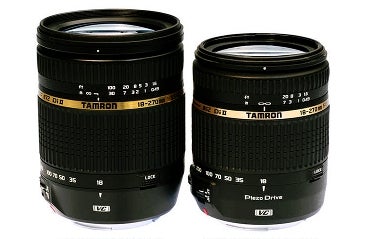Tamronu2019s new 18-270mm, with its piezoelectric motor, was named EISAu2019s European Zoom Lens of the Year 2011-12. Yet the same Tamron 18-270mm zoom failed to shine when tested for the October edition of WDC. How can that be?
There is no denying that the new version of Tamron’s 18-270mm super-zoom improves on its predecessor in a number of ways. As the picture above shows, the new 18-270mm lens is smaller than the previous version. It also has a lower mass and a smaller accessory thread. A significant contributor to this change is the use of a standing-wave piezoelectric focusing motor.
In its citation, EISA found that the new motor achieves “near-silent autofocus”. EISA also praised the Tamron’s comfortable handling, wide aperture (at 18mm) and broad expanse of focal lengths across its 18-270mm range. None of these high-points is contested in WDC’s review.
EISA does not mention any areas of weakness when discussing the new 18-270mm superzoom but some were noted in the WDC report. For example, AF operation was found to be reliable but “not especially quick”. Tamron claims its piezoelectric motor is “faster and quieter” than DC motors but that is not the same as “fast and quiet” in absolute terms. Yes, it does handle very nicely but the focusing ring rotates in AF mode and fingers must be kept clear of it to avoid hindering the mechanism.
The MTF curves obtained for my WDC test were good but not outstanding, hovering around the critical 0.25 cycles-per-pixel threshold.
Of course the headline feature of this lens is its 15x zoom range (270/18=15) which is undeniable, but the 18-270mm zoom range has not changed since 2009, when the previous version of this lens won another EISA European Zoom Lens of the Year title. Personally, I doubt whether making the lens a bit smaller and adding a piezoelectric motor really justifies a second award. And, as it happens, the DxO Mark website (http://www.dxomark.com) also reports only an average set of results for this lens.
So where does that leave us? Given that DxO’s tests and WDC’s review both point to a capable rather than remarkable level of performance, it seems probable that EISA’s award reflects the potential that Tamron’s zoom offers for picture-taking more than the technical results that the lens delivers.
There is nothing wrong with EISA highlighting Tamron’s new 18-270mm lens but photographers who are prepared to settle for a slightly more modest zoom range are likely to find that they are rewarded with better results – albeit over a more restricted set of focal lengths. EISA has clearly weighted the zoom range offered by this lens higher than that particular feature is placed by either DxO or WDC.
Fortunately, there are no right and wrong answers when it comes to buying lenses. Every opinion is worth listening to and if you are after the biggest possible zoom range then Tamron’s new 18-270mm f/3.5-5.6 Di-II VC PZD lens is definitely worthy of serious consideration – as EISA recommends!





